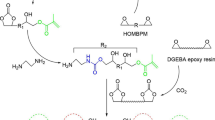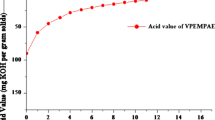Abstract
The urethane vinyl ester resins (UVERs) with high chemical resistance and mechanical properties such as superior elongation are one of the essential classes of thermoset polymers. Herein, we describe the synthesis of UVER without the use of isocyanate. The use of isocyanate as the primary starting material in the polyurethane production might cause environmental risks; thus, non-isocyanate polyurethane (NIPU) can be prepared without applying isocyanate. Initially, glycidyl methacrylate (GMA) was converted to cyclic carbonate of GMA (CGMA) by applying atmospheric pressure of carbon dioxide and tetrabutylammonium bromide (TBAB) as a catalyst. Formation of product was confirmed by observing carbonyl of the cyclic carbonate peaks and disappearing the epoxy peaks in FT-IR and NMR spectra. Afterward, CGMA was treated with different diamines (ethylenediamine, hexa-, hepta-, octa- and nonamethylenediamine, and m-xylylenediamine) to produce UVER. The detection of new bonds of the urethane groups and the elimination of the peak of cyclic carbonate groups via FT-IR and NMR approved the cyclic carbonate conversion into the hydroxyurethane system. Finally, VER is cured using different percentages of non-isocyanate-based UVER (0, 30, 40, 50 and 70%) applying benzoyl peroxide and N, N-dimethylaniline in the role of initiator and accelerator, respectively. Various characterization techniques such as FT-IR and ATR spectroscopy, rheometery, DSC, TGA and tensile test are conducted to confirm different weight ratios of UVER-VER% synthesis.
Graphical Abstract
Synthesis and characterization of UVER without the use of isocyanate were described. Initially, glycidyl methacrylate (GMA) was converted to cyclic carbonate of GMA in the presence of carbon dioxide. Afterward, CGMA was treated with different diamines to produce UVER. Finally, VERs are cured using different percentages of non-isocyanate-based UVERs.
















Similar content being viewed by others
References
Al Nakib R, Toncheva A, Fontaine V, Vanheuverzwijn J, Raquez JM, Meyer F (2022) Thermoplastic polyurethanes for biomedical application: a synthetic, mechanical, antibacterial, and cytotoxic study. J Appl Polym Sci 139:51–666
ASTM D (1998). 2074–92. Standard test methods for total, primary, secondary, and tertiary amine values of fatty amines by alternative indicator method. ASTM International, West Conshohocken, Pennsylvania
Boisaubert P, Kébir N, Schuller AS, Burel F (2020) Photo-crosslinked non-isocyanate polyurethane acrylate (NIPUA) coatings through a transurethane polycondensation approach. Polymer 206:122–855
Burelo M, Gaytán I, Loza-Tavera H, Cruz-Morales JA, Zárate-Saldaña D, Cruz-Gómez MJ, Gutiérrez S (2022) Synthesis, characterization and biodegradation studies of polyurethanes: effect of unsaturation on biodegradability. Chemosphere 23:136136
Cook WD, Simon GP, Burchill PJ, Lau M, Fitch TJ (1997) Curing kinetics and thermal properties of vinyl ester resins. J Appl Polym Sci 64:769–781
Fałtynowicz H, Janik H, Kucinska-Lipka J, Sienkiewicz M (2022) Polyurethanes handbook of thermoset plastics. Elsevier
Fan LH, Hu CP, Ying SK (1997) Mechanical properties of hand-cast and reaction injection molded polyurethane and vinyl ester resin interpenetrating polymer networks. Polym Eng Sci 37:338–345
Fink JK (2017) Reactive polymers: fundamentals and applications: a concise guide to industrial polymers. William Andrew
Goodman SH (1986) Handbook of thermoset plastics. Noyes Publications, USA
Goswami S, Ranjan JK (2020) Study of mechanical and thermomechanical properties of vinyl ester/polyurethane interpenetrating polymer network based hybrid composites. Fibers Polym 21:1096–1114
Grishchuk S, Karger-Kocsis J (2012) Modification of vinyl ester and vinyl ester–urethane resin-based bulk molding compounds (BMC) with acrylated epoxidized soybean and linseed oils. J Mater Sci 47:3391–3399
Grishchuk S, Karger-Kocsis J (2017) Vinyl ester resin modified with acrylated epoxidised soybean (AESO) and linseed (AELO) oils: effect of additional urethane crosslinking. Polym Polym Compos 25:363–370
International A (1997) ASTM D1652–97-Standard Test Methods for Epoxy Content of Epoxy Resins: ASTM International West Conshohocken
Johnson R, Arumugaprabu V, Ko TJ (2019) Mechanical property, wear characteristics, machining and moisture absorption studies on vinyl ester composites–a review. SILICON 11:2455–2470
Khatri CA, Stansbury JW, Schultheisz CR, Antonucci JM (2003) Synthesis, characterization and evaluation of urethane derivatives of Bis-GMA. Dent Mater J 19:584–588
Launikitis MB (1982) Vinyl ester resins handbook of composites. Springer, Boston, MA
Ling Z, Zhang C, Zhou Q (2022) Synthesis and characterization of 1 K waterborne non-isocyanate polyurethane epoxy hybrid coating. Prog Org Coat 169:106–915
Mazurek M, Parzuchowski PG, Rokicki G (2015) Non-isocyanate polyurethanes: synthesis, properties, and applications. Polym Adv Technol 26:707–761
Monie F, Grignard B, Thomassin JM, Mereau R, Tassaing T, Jerome C, Detrembleur C (2020) Chemo-and regioselective additions of nucleophiles to cyclic carbonates for the preparation of self-blowing non-isocyanate polyurethane foams. Angew Chem Int Ed 132:17181–17189
Nodehi M (2022) Epoxy, polyester and vinyl ester based polymer concrete: a review. Innov Infrastruct Solut 7:1–24
Ochiai B, Sato SI, Endo T (2007) Crosslinkable polyurethane bearing a methacrylate structure in the side chain. J Polym Sci Part A Polym Chem 45:3400–3407
Rodrigues JD, Andrade CK, Quirino RL, Sales MJ (2022) Non-isocyanate poly (acyl-urethane) obtained from urea and castor (Ricinus communis L.) oil. Prog Org Coat 162:106–557
Salman AJ, Al-Obaidi AA, Al-Mamoori DH, Shaker LM, Al-Amiery AA (2021) Thermal, mechanical and morphological properties of polyurethane–zirconia loading. IJLCT 16:454–462
Schimpf V, Asmacher A, Fuchs A, Bruchmann B, Mülhaupt R (2019) Polyfunctional acrylic non-isocyanate hydroxyurethanes as photocurable thermosets for 3D printing. Macromolecules 52:3288–3297
Suresh G, Bernard SS, Vivek S, Krishnan GS, Kishore VA, Paul AI, Fowzan KM (2021) Study of mechanical performance of E-glass fiber reinforced (IPN) interpenetrating polymer networks. Mater Today Proc 45:573–577
Yang Y, Cao H, Wang Y, Zhao J, Ren W, Wang B, Cai D (2022) Non-isocyanate polyurethane from sweet potato residual and the application in food preservation. Ind Crops Prod 186:115–224
Zafar F and Sharmin E (2012) Polyurethane. Polyurethane. In: Zafar F, Sharmin E (eds) INTECH Rijeka, Croatia
Zareanshahraki F, Asemani H, Skuza J, Mannari V (2020) Synthesis of non-isocyanate polyurethanes and their application in radiation-curable aerospace coatings. Prog Org Coat 138:105–394
Zhang J, Richardson M (2000) Micro-heterogeneity of urethane vinylester resin networks. Polymer 41:6843–6849
Acknowledgements
The authors would greatly appreciate the partial support of this study by Shiraz University Research Council
Author information
Authors and Affiliations
Corresponding author
Ethics declarations
Conflict of interest
On behalf of all authors, the corresponding author states that there is no conflict of interest.
Additional information
Publisher's Note
Springer Nature remains neutral with regard to jurisdictional claims in published maps and institutional affiliations.
Supplementary Information
Below is the link to the electronic supplementary material.
Rights and permissions
Springer Nature or its licensor (e.g. a society or other partner) holds exclusive rights to this article under a publishing agreement with the author(s) or other rightsholder(s); author self-archiving of the accepted manuscript version of this article is solely governed by the terms of such publishing agreement and applicable law.
About this article
Cite this article
Ghasemi, S., Ghezelsofloo, M. Isocyanate-free urethane vinyl ester resin: preparation, characterization and thermal and mechanical properties investigation. Chem. Pap. 77, 1165–1180 (2023). https://doi.org/10.1007/s11696-022-02547-9
Received:
Accepted:
Published:
Issue Date:
DOI: https://doi.org/10.1007/s11696-022-02547-9




